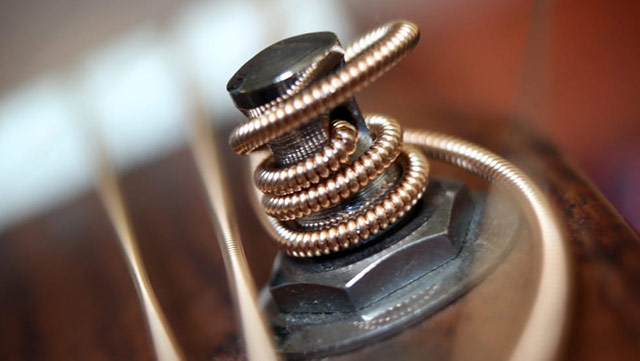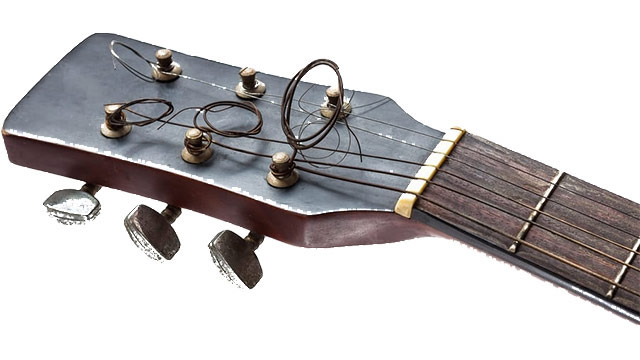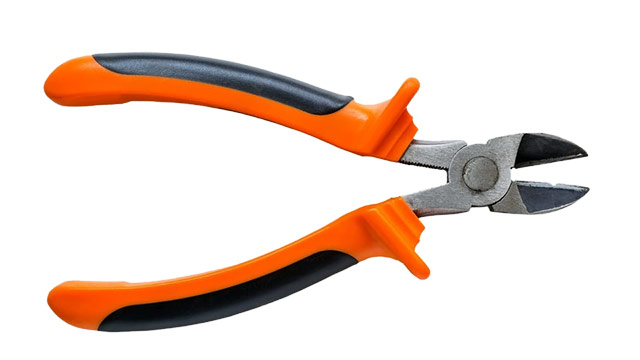The guitar is one of the most popular and versatile musical instruments. They only need a little maintenance apart from cleaning and tuning. Restringing the guitar is something you have to do when the strings start sounding dead or breaking. Some people keep their strings for longer, while others like the sound of new strings and change it more often.
Whichever is the case for you, you’ll find out that while putting on new strings doesn’t require any specialized tools, cutting the excess strings does require a wire clipper.
But what if you don’t have one lying around? How do you cut guitar strings without clippers?
There are several ways to cut guitar strings without a wire clipper. You can use a nail clipper/cutter, a pair of heavy-duty scissors, or a knife. You can also try bending and wiggling the string, which gives an excellent cut. Many people also have pliers in their home or car toolbox, one of the best everyday tools you can use to cut guitar strings.
How To Cut Guitar Strings Without Clippers
Cut Guitar Strings With a Nail Clipper
A nail clipper is something everyone has and can be used to cut guitar strings. In fact, it does quite a good and clean job of doing that. However, it’d be wise to use an old clipper and stop using it for clipping afterwards. Because you guessed it, nail clippers are not meant for string cutting, and while it does manage to get the job done, their sharpness and effectiveness are affected. And clipping your nails with it would certainly not be a good idea because of the deformed cutting surface.
Since nail clippers are cheap, you can get one from the dollar store and use it exclusively to cut guitar strings. And as mentioned, they do quite a good job of it.
Cut Guitar Strings With Scissors
Scissors can also come in handy when you’re trying to cut guitar strings. Depending on the scissor, whether the smaller, flimsier ones or the heavy-duty kitchen or sewing scissors, you’ll be able to get a cut ranging from decent to very clean. One advantage is that you’ll be able to cut at pretty much the exact point you wanted to cut and with relative ease.
But, again, like the nail clippers, the scissors may as well get damaged in the process rendering them ineffective for their everyday cutting needs. The heavy-duty carbon-steel scissors might be able to come undamaged after your guitar string-cutting adventure, but I wouldn’t advise taking chances with a $20 scissor just to find out.
If you have an extra pair of scissors, put them to use by trying this out, and as long as they are sufficiently sharp, they will get the job done with relative ease. But please don’t try this with children’s scissors or other small flimsy scissors. For the thicker strings, they might end up taking the winding off without being able to cut the core string, which is not something you want.
Cut Guitar Strings With Pliers
The best way to cut guitar or even bass guitar strings (that are much thicker) with tools most people keep at home is the good old pliers. Almost all pliers, whether long-nosed or the usual lineman pliers have a wire-cutter functionality. A decent-quality hardened steel plier can cut the guitar strings very well without damaging itself. In my experience, the cut is flawless, and it doesn’t take much effort, either.
If you don’t have one, why not consider getting one? They are pretty cheap and can do various things besides cutting guitar strings. It is one of the most valuable tools to have in your toolbox other than screwdrivers.
Cut Guitar Strings With Some Elbow Grease
I don’t know about you, but as a kid, when we didn’t have access to tools because our parents deemed them dangerous, we used to cut wires by just wiggling them back and forth. And I remember the cut looked so clean, like you just used some laser cutters on them!
You can do the same for guitar strings, but since the guitar strings are generally softer and more springy, it might take some jiggling. You can even try a neat trick by using two coins to hold the string in place with one hand firmly and using the other to bend the string up and down rapidly. The coins will ensure your fingers don’t come in contact with the string, which may get hot and keep it from moving.
With this method and some patience and effort, you’ll be able to get a clean cut without using any tool. The wound strings may get a proper, cleaner cut in some cases. For better chances of getting a cleaner cut on these thicker strings, try this first on the unwound strings. By the time you have cut two or three strings, you’ll be able to get a better job with the wound strings. And do use coins for these thicker strings. It’ll also improve your chances of getting a clean cut.
Cut Guitar Strings With a Pocket Knife/Box Cutter
If you have a pocket knife, you can use it to cut guitar strings. Many pocket knives, meant for camping and outdoor activities, are pretty tough.
Place the string on a piece of wood or playboard and use the knife to press on it. The thinner strings may cut right away. The knife press will kink the string for the thicker strings, and a gentle wiggle will snap it clean.
You can also use a box cutter; for this, try to use the very tip of the blade. Most box cutter blades have seams that allow a small portion of the blade to be snapped off when they get blunt. Cutting a guitar string will probably damage the blade, so you should snap off that portion of the blade, and your box cutter will be as good as new.
As always, be extra careful with the knife as they are very sharp and don’t try cutting the string while holding the string in the air because you feel lazy to get a piece of wood or the chopping board.
Where To Cut Guitar Strings

After you restring the guitar and have it in tune, you’ll be left with some excess string at the tuning posts. Some people leave it like that, while most people cut them off as the excess strings look bad and are dangerous as well. Ideally, it would be best if you cut the string leaving around a 1/2-3/4th inch excess so that the strings don’t slip out of the tuners. Most people suggest having 2-4 winds around the tuning post, so keep that in mind before cutting the strings. Just one or two winds, especially for unwound strings, won’t be enough and may cause the string to slip over time and affect the tuning stability.
If you like to cut their strings before you start winding, you can hold the string close to the tuning post and cut it at around 2.5 inches past the tuning post. Now, bend about 1/2 inch at the end of the string, put it through the tuning post hole (facing sideways), and start winding. This should give you around 2-3 wounds around the post which should be good enough.
Also check out: Do Guitar Strings Go Bad in Their Package?
Should You Cut Excess String on Guitar?
Most guitar teachers will tell you to trim the excess string off. I like to keep my strings clipped as well, which I’d suggest you do. Some, especially younger people, say they like the look of the headstock with uncut strings. Still, apart from looking untidy, they can also be dangerous as they can accidentally poke into your or someone else’s eyes. You should be extra careful if you’re playing around children because they usually don’t have swift reflexes and can get hurt by the strings’ sharp ends.
Why Do Guitar Players Leave Strings Uncut?

Out of all the people I have met that leave the strings uncut, many say they like how the headstock looks with the uncut strings. Some keep the messy look, while others make loops. Some say it helps keep their guitars in tune much better (which I don’t believe).
A few people, especially those using Floyd Rose or similar bridges that don’t need strings with ball ends, say the excess length of strings comes in handy in a pinch if their strings break near the bridge.
And only a few others, mostly honest people, accept that they were just plain lazy!
Get a Wire Cutter – Best Tool for Cutting Guitar Strings

While most of the methods mentioned in this article are effective and can help you when you’re in a bind without a wire cutter, you should certainly get one – they are cheap, and even the $5 ones will last a long time.
When you’re using alternative methods, like the ones mentioned here, there is always a chance you might ruin a string, especially the wound strings. You might cut the strings too short without leaving much excess, and if it isn’t a good, clean cut, the winding may start coming off. This might reduce your tuning stability or even render the string pretty much useless because it can’t stop slipping off.
Therefore, put it on your to-do list and get a wire cutter the next time you visit a hardware store. After all, that’s something every guitarist (and even every toolbox) should have.


